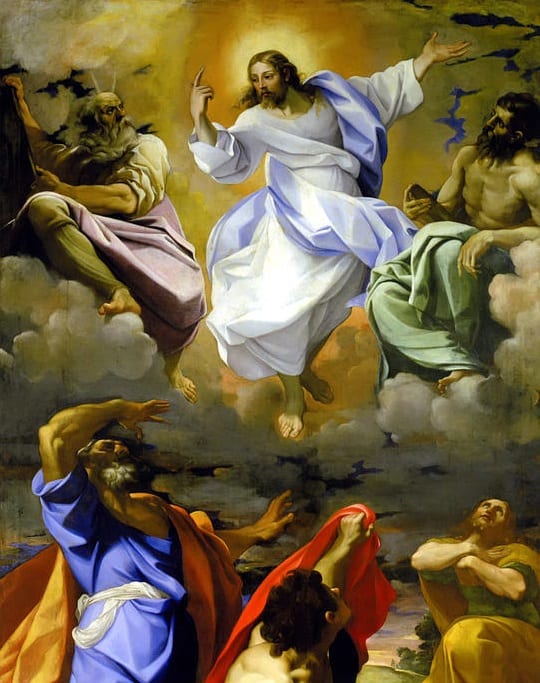
Listen to Him!
The Gospel account of the Transfiguration appears in all three synoptic Gospels; comparing all three with one another gives us a fuller picture of the event: In summary, Jesus led Peter, James and John up a high mountain where He was physically transfigured – His face shone like the sun and His clothes became dazzling white (white as light). Moses and Elijah appeared and conversed with Jesus; they talked about His exodus that He was to accomplish in Jerusalem (Lk 9:31). Peter spoke up about building three tents – one for Moses, one for Elijah and one for Jesus. Suddenly, a bright cloud cast a shadow over them and a voice said, “This is my beloved Son, listen to Him.” Basically, the Gospel account of the Transfiguration confirms that Jesus is the Son of God (Mt 17:5, Mk 9:7, Lk 9:35) and it prefigures His coming in glory at the end of the age (Mt 16:27).
Why did Peter suggest building booths on the mountain? The Feast of Booths, which is a harvest festival, is a joyful celebration; therefore, some commentaries say that Peter could be enthused about building booths due to the joy that he felt at the moment of the Transfiguration. Other commentaries suggest that Peter had the idea of building booths to serve as monuments to honor Jesus, Moses and Elijah. Let’s take a closer look at this. What connections can we make of the building of booths and the Transfiguration of Christ? What message did the Gospel writers want to convey?
It was on a mountain that God revealed the Ten Commandments to Moses (Ex 24:12-18), and it was on the same mountain that God revealed Himself to Elijah (1Kgs 19:8-18). That mountain was Mount Sinai (aka Mount Horeb). Although Jesus and His disciples were not on Mount Sinai, it was on a mountain where the three disciples witnessed the magnificent revelation of the Transfiguration of Christ.
Moses spent forty days and nights on Mount Sinai, while Elijah walked forty days and forty nights to the same mountain. A prominent feature of the Exodus was that while the Israelites wandered through the desert for forty years, they dwelled in booths. In Leviticus, the Israelites were commanded to commemorate their exodus from Egypt by dwelling in booths for seven days (Lv 23:42-43). It is no coincidence that at the Transfiguration, Jesus was talking with Moses and Elijah about His coming “Exodus” in Jerusalem; Jesus’ “Exodus” refers to His Passion, Death and Resurrection. In the Passion, Death and Resurrection of Christ, Christians would be delivered from the bondage of sin and death.
Peter was still thinking in the ways of the Old Law by building booths, but the voice from the cloud said, “Listen to Him!” (Mt 17:5, Mk 9:7, Lk 9:35) The disciples were being instructed by God to listen to His Son, Jesus Christ, because Christ has fulfilled the Old Law. At the Sermon on the Mount, Jesus taught the crowds; regarding the Old Law, He said, “Do not think that I have come to abolish the law or the prophets. I have come not to abolish but to fulfill.” (Mt 5:17) Jesus fulfilled the prophecies of the Old Testament, and in His teachings, He fulfilled the Old Law by making it perfect: not only should one not kill, but also not hate; not only should one not commit adultery, but also be pure of heart; that it is not enough not to take a false oath, but that they must be truthful to the extent that taking oaths is unnecessary. Now, at the Transfiguration of Christ, God the Almighty Father is telling the disciples to “Listen to Him!”
What about us? In this season of Lent, the Transfiguration of Christ calls us to reflect on some questions: Do we pay attention to the teachings of Jesus? Do we try to follow His example? Do we make Jesus the center of our lives?